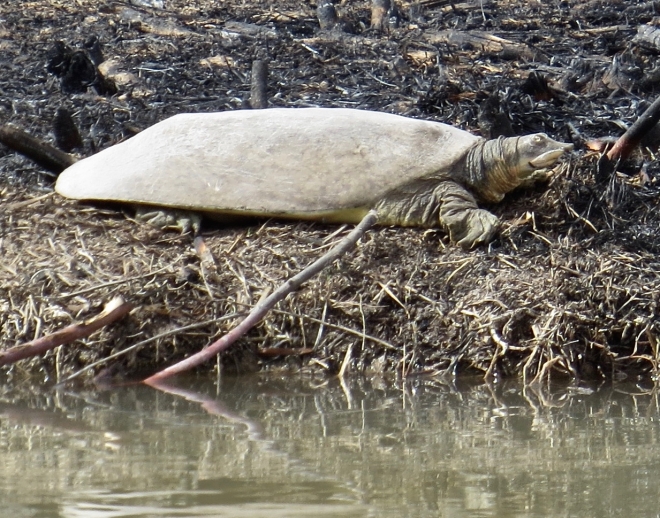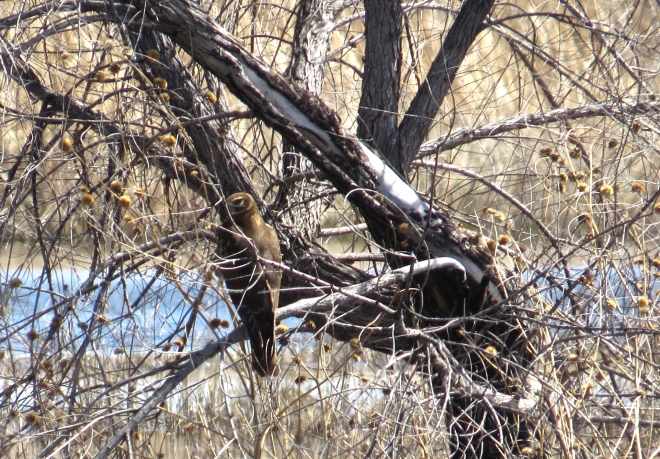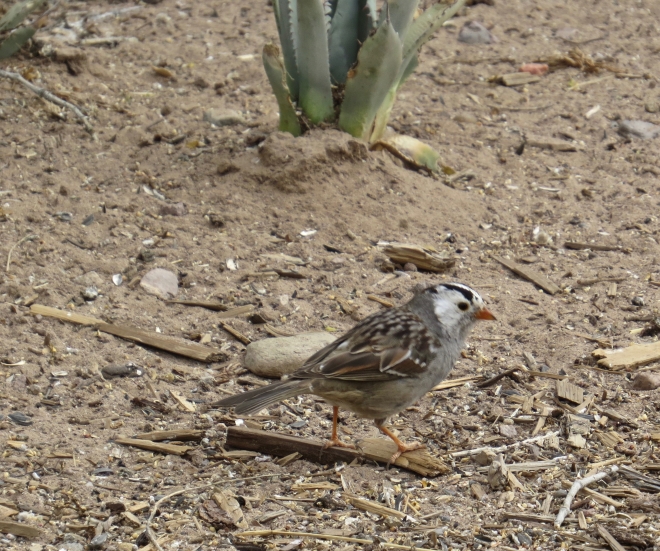
This is not the tail of a cat
Birding gets you outdoors. It puts you in a specific place at a specific moment of time with all your senses open and receptive. And then you just never know what might pop up to surprise you.
This story takes place at Bosque del Apache NWR in central New Mexico on a day in early March. It began with witnessing what may have been the last large group of Sandhill Cranes leaving the refuge for their journey north. A couple hundred flew over before I even got to the refuge, but at the entrance road pond there were still an estimated 600-700 birds clustered, taking off at intervals in groups of varying sizes, filling the air with crane music. Over the course of 15 minutes every one of them had lifted off and I never saw or heard another the entire day. There are always a few stragglers that hang around well into late March, but the majority by now are winging their way to the nesting grounds.

This softshell turtle is lying on a patch of earth that had recently been burned. It lay unmoving for so long I began to worry it might have been caught unawares by fast-moving flames and heat and had died there. But when I opened the car door it literally spun and leapt into the water in maybe 1/10 of a second. I had no idea they could move at such speed.

This female Ladder-backed Woodpecker worked her way from one water weed to the next
I just don’t associate woodpeckers with water, but Ladder-backs seem especially adaptable in their choice of hunting locations. I’ve seen them on chollas and poking around at the base of creosote. As I walked north along the edge of the Flight Deck pond, this female never once left the flooded shoreline as she foraged her way just ahead of me.

Female Northern Harrier, perched on tree surrounded by water
On the west side of South Loop, I had stopped to look at ducks when I noticed movement through the woods in a large flooded area. It was a long line of mule deer wading single file through belly-deep water. One after another they appeared through an opening, all walking at the same stately pace a few feet behind each other and disappearing on the other side of the gap. The effect was similar to some of those looped tapes you might see on YouTube as the deer just kept appearing. I had counted 21 before I moved on, and still they came.
Ended the day at the visitor’s center. Had a Green-tailed Towhee in the cactus garden.

Green-tailed Towhee
Plus this partially leucistic White-crowned Sparrow. Or maybe it’s the love child of a White-crown and a White-breasted Nuthatch.

An anomaly. White-crowned Sparrow with white cheeks, partially leucistic bird

Here’s an article that explains leucism. Essentially it’s a genetic mutation that prevents pigment from being deposited in feathers. Bird Leucism

The biggest highlight of the day, however was the red streak of a mammal that flashed across the path in front of me as I was leaving the cactus garden. And yes, that tail photo at the top of this post belongs to it. It was a Long-tailed Weasel, a masked southwestern subspecies.

Long-tailed Weasel. Mustela frenata. A masked subspecies like this one is found throughout the southwest.
I crept up the path to the point where I had seen the streak disappear. A few moments later I looked to my left and there it was, eyeing me.

It began moving towards me in cautious fits and starts. I was torn between wanting to get photos, wanting to just stop and look, and worrying that it might be rabid and on its way to sink sharp teeth in my foot.

Instead, it seems it was just deciding if I posed a threat or not. Here it’s turned away and looking intently at something.

Weasel and wood rat
I probably startled it right after it made this kill. I think it’s a wood rat as it had a long hairless tail. The weasel snatched it up and ran off with it in her mouth. It must have weighed at least as much as she did. With that long skinny body she wove a crooked path, curving at times like a snake around obstacles. I followed but lost sight of her after about 75 feet.
You may notice I switched to saying ‘her’. When I got back down to the visitor’s center one of the volunteers was standing outside, looking as excited as I was. She had just seen it run by and around the west side of the building with the large rodent. The volunteer said they had seen her one morning about a month ago under the observation window and she was very plump at that time. Their theory is that she’s raising young right now, and hunting pretty far afield trying to keep up with the energy demands of that task.
Sometimes the bird of the day isn’t a bird at all. And if it weren’t for the birding passion (possibly I could even say obsession) I wouldn’t have been out there for all the wonders the day held.